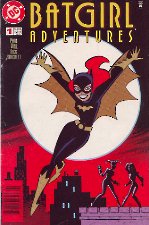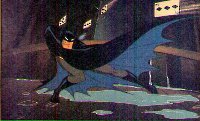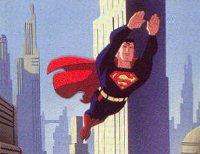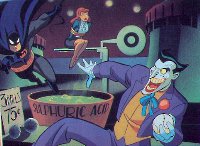 Shadow
of the Bat - (Written by Brynn Stephens, Directed by Frank Paur)
- The first episode that immediately springs to mind (although it wasn't one of the first episodes aired) is
Shadow of the Bat. Originally shown in two parts in 1993, this was one of the last Fox-era episodes.
It also introduced Batgirl into the animated series' continuity. Now, please bear in mind that Batgirl was a character I never liked either in the 1960s series or in the comic books. With all apologies to Yvonne Craig, she seemed gimmicky, overly cute, and mainly unbelievable. Nevertheless, I rank Shadow of the Bat as one of the best stories of the animated series, and I
also think that the animated version of Batgirl is the best incarnation of the character. Check out the Batman:Subzero film if you'd like to see more of the assertive Batgirl of the 90s.
Shadow
of the Bat - (Written by Brynn Stephens, Directed by Frank Paur)
- The first episode that immediately springs to mind (although it wasn't one of the first episodes aired) is
Shadow of the Bat. Originally shown in two parts in 1993, this was one of the last Fox-era episodes.
It also introduced Batgirl into the animated series' continuity. Now, please bear in mind that Batgirl was a character I never liked either in the 1960s series or in the comic books. With all apologies to Yvonne Craig, she seemed gimmicky, overly cute, and mainly unbelievable. Nevertheless, I rank Shadow of the Bat as one of the best stories of the animated series, and I
also think that the animated version of Batgirl is the best incarnation of the character. Check out the Batman:Subzero film if you'd like to see more of the assertive Batgirl of the 90s.
The episode begins with a nice establishing sequence in which Batman confronts crime boss Rupert Thorne on a rooftop. The dialogue is concise, the scene is well-written, and - without having to do anything too elaborate - Batman makes a great entrance. Someone who's never heard of Batman would undoubtedly appreciate that entrance as much as a long-time fan. The scene also establishes Commissioner Gordon as a hardworking detective in his own right, and Sergeant Bullock as a crude but no-nonsense police officer. If only the Tim Burton Batman films had an opening scene like this one . . .
Within the first 15 minutes or so of the story, we're introduced to the Commissioner's daughter Barbara and, within the same sequence, the Commissioner is arrested on charges of conspiracy. There's no doubt in Barbara's mind (or ours) that the Commish has been framed, and she immediately seeks out the Batman for help. The Dark Knight, however, is his usual mysterious self and refuses to attend a public rally for the Commissioner's release. And so, Barbara takes matters into her own hands and fashions a Batman-like costume with the intent of impersonating the Dark Knight at the rally.
Again, the storytelling is amazingly economical. There are no distracting subplots. Not a single line is thrown away, and every scene moves the story forward. This is a model of taut, concise screenwriting and directing; it represents an art form which was once commonplace in Hollywood but which now is depressingly rare. By the time Shadow of the Bat concludes, Batgirl has won the respect of the Batman - along with the respect of fans like me who once dismissed her character. Kudos to all involved!
The episode works not only because it's well-crafted. It also celebrates and pokes fun of the various clichés surrounding Batman and Superman. The characterization is first-rate, and I've never enjoyed Tim Daly more in his portrayal of Superman. He perfectly captures Superman's mixture of Boy Scout naiveté and decent Middle-American morality. While some purists might consider this a Superman Adventures episode rather
than a Batman Adventures episode, there is no doubt that the Batman mythos are the prime reason for everything that happens in this story.
While the plot is straightforward with some clever twists, the story stays in my mind because it is so darned odd. O'Flaherty, Ruegger, and Wolf fill in part of Batman's back story, and allow us to speculate on further missing pieces. After his parents' murder, Bruce Wayne obviously came to idolize at least one strong male figure in the media. (Speaking from personal experience with parental abandonment, I'd say that
Wayne isn't the only person who looked for a surrogate father elsewhere.) Much of Batman's technique and methodology seems to have been influenced by the Gray Ghost - the dark clothes, the obsessive vigilante persona, the inspiration of fear in his enemies, the use of clever crime-fighting gadgets. All of this makes sense since it seems unlikely that even the Batman could have emerged solely from the imagination of Bruce Wayne. Up
until this point the story is almost reassuring. It's comforting to see a Golden Age-style character serving as the Batman's mentor.
The story is disturbing because neither Batman nor the Gray Ghost seem to regard the Gray Ghost as just a television character. (The writers also don't seem to be certain if the Grey Ghost is a movie character or a TV character, but I digress). In the feature film Fright Night, the young heroes recruit a local horror host (played by Roddy McDowall) to act as a vampire hunter; unlike the Gray Ghost in Beware the Gray Ghost, the horror host is initially annoyed and angered that some fans have confused his acting career with his real
life. In Beware the Gray Ghost, Batman consults his hero for help in solving a mystery, which would be akin to asking Alan Alda to remove someone's gall bladder because he played a great surgeon on M*A*S*H some years ago. The Gray Ghost, for his part, is totally willing to dress in a decades-old costume and assist Batman fight crime. There are many action heroes in real life (Clayton Moore and John Wayne are two examples)whose films and lives blurred so much it's impossible for us to untwine them. Is this psychologically healthy? Of all the DC Heroes, Batman always seemed to be the least mentally stable. He may have been brilliant, but he was also obsessive-compulsive and given to bouts of paranoia. None of this is mentioned explicitly in Beware the Gray Ghost. Perhaps
I'm reading too much into this. But - to these eyes, at least - the subtext is unmistakable.
This is my favorite of all the Batman:The Animated Series installments.
Sometimes I wish that we'd been allowed to see more of the Gray Ghost in
other episodes. And at other times, I'm glad that he was simply a one-shot
character. Either way, I'm glad that the episode was created. Like the
best of the Batman animated adventures, Beware the Gray Ghost proves
that animated cartoons can be as dramatic and suspenseful as the very best
live-action movies.
In October 2000, look for the
second installment of this essay. I'll
examine why the Batman "animated-style" comics are among the best values in comics today. You'll also finally see an online interview I did with Ty Templeton a while back.
 Knight
Time (Written by Robert Goodman, Directed by Curt Geda)- Once Superman Adventures was underway, Bruce Timm and Paul Dini decided to team Batman and Superman in a handful of adventures. The first(and best known) was a made-for-TV feature called World's Finest,
but the finest team-up was Knight Time. Unlike the other TV team-ups, Knight Time harkens back to the Silver Age cliché of Batman and Superman switching identities - and Knight Time works because it avoids the inherent silliness of Batman impersonating the Man of Steel.
Knight
Time (Written by Robert Goodman, Directed by Curt Geda)- Once Superman Adventures was underway, Bruce Timm and Paul Dini decided to team Batman and Superman in a handful of adventures. The first(and best known) was a made-for-TV feature called World's Finest,
but the finest team-up was Knight Time. Unlike the other TV team-ups, Knight Time harkens back to the Silver Age cliché of Batman and Superman switching identities - and Knight Time works because it avoids the inherent silliness of Batman impersonating the Man of Steel.
 In the beginning of the episode, Batman is missing from Gotham City, and Gotham's
criminals are going wild. Superman finds out and flies to Gotham. After winning Robin's trust, Superman impersonates Batman and helps Robin investigate the mystery. Along with way, we're treated to several hilarious scenes in which Robin chastises Superman for smiling too often and not acting
"mysterious" enough, and a classic confrontation between Superman (as Batman) and an understandably bewildered Bane.
In the beginning of the episode, Batman is missing from Gotham City, and Gotham's
criminals are going wild. Superman finds out and flies to Gotham. After winning Robin's trust, Superman impersonates Batman and helps Robin investigate the mystery. Along with way, we're treated to several hilarious scenes in which Robin chastises Superman for smiling too often and not acting
"mysterious" enough, and a classic confrontation between Superman (as Batman) and an understandably bewildered Bane.
 Beware
the Gray Ghost - (Written by Dennis O'Flaherty and Tom Ruegger, Teleplay by Garin Wolf and Tom Ruegger, Directed by Boyd Kirkland) - Perhaps the most infamous of the Fox-era adventures, this 1992 episode contains the much celebrated voice talents of Adam West as the inspiration for Kevin Conroy's Batman. Putting aside the obvious irony of having West voice a character who is a pulp star fallen on hard times, this is
a rare occasion for us to see Batman in a deferential position. Batman obviously respects the Gray Ghost, even though the Gray Ghost is only a movie character; the storyline is filled with tips of the hat to several 1930s-era heroes like the Shadow and the Green Hornet that inspired Bob Kane when he created the Batman in 1939. The Dini-Timm Batman can be an arrogant autocrat, and it is truly refreshing to see him respect someone
aside from Commissioner Gordon.
Beware
the Gray Ghost - (Written by Dennis O'Flaherty and Tom Ruegger, Teleplay by Garin Wolf and Tom Ruegger, Directed by Boyd Kirkland) - Perhaps the most infamous of the Fox-era adventures, this 1992 episode contains the much celebrated voice talents of Adam West as the inspiration for Kevin Conroy's Batman. Putting aside the obvious irony of having West voice a character who is a pulp star fallen on hard times, this is
a rare occasion for us to see Batman in a deferential position. Batman obviously respects the Gray Ghost, even though the Gray Ghost is only a movie character; the storyline is filled with tips of the hat to several 1930s-era heroes like the Shadow and the Green Hornet that inspired Bob Kane when he created the Batman in 1939. The Dini-Timm Batman can be an arrogant autocrat, and it is truly refreshing to see him respect someone
aside from Commissioner Gordon.
All character names and images in this essay
are copyrights of DC Comics and Warner Brothers. The graphics used to illustrate
this essay came from various promotional items related to the television
programs "Batman:The Animated Series" and "Superman Adventures" and were
scanned with the purpose of illustrating this essay. DC Comics and Warner
Brothers retain all copyrights related to these images. The scans are used
according to the guidelines of the Fair Use Doctrine. This essay is not
sponsored by DC Comics or Warner Brothers in any way, and was written and
published by Dan Patanella in 2000. The text of this essay may not be reproduced
save for non-profit purposes without the express written permission of
Dan Patanella.




